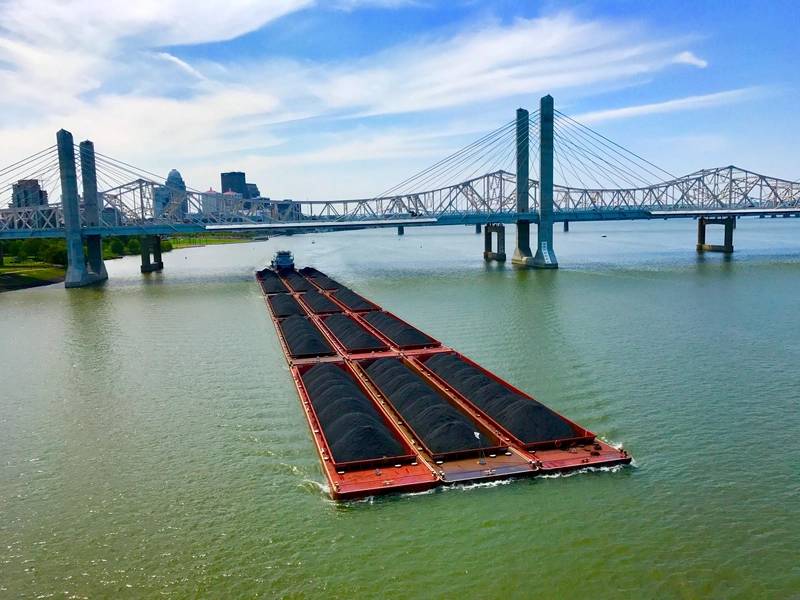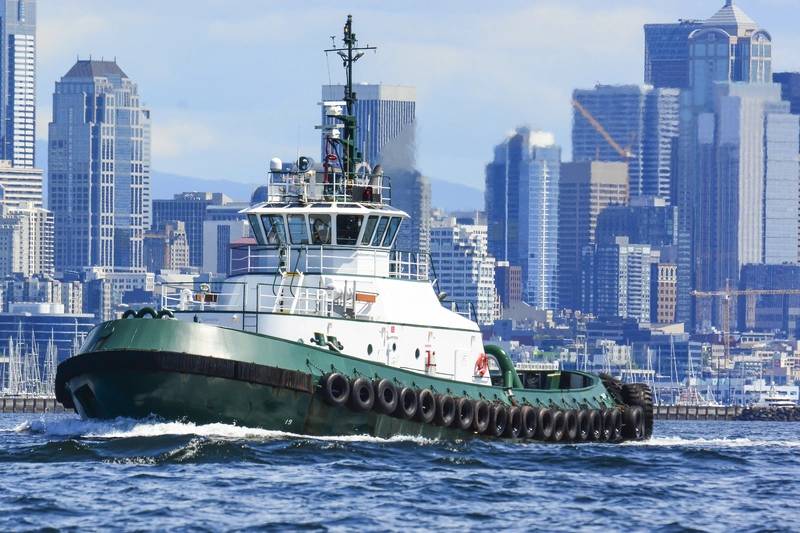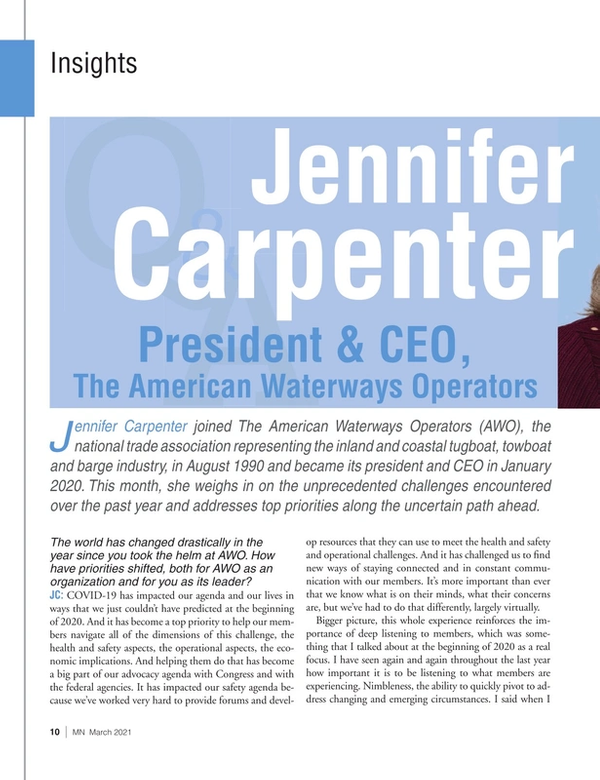
Interview: Jennifer Carpenter, AWO President & CEO
Jennifer Carpenter joined The American Waterways Operators (AWO), the national trade association representing the inland and coastal tugboat, towboat and barge industry, in August 1990 and became its president and CEO in January 2020. She weighs in on the unprecedented challenges encountered over the past year and addresses top priorities along the uncertain path ahead.
The world has changed drastically in the year since you took the helm at AWO. How have priorities shifted, both for AWO as an organization and for you as its leader?
COVID-19 has impacted our agenda and our lives in ways that we just couldn’t have predicted at the beginning of 2020. And it has become a top priority to help our members navigate all of the dimensions of this challenge, the health and safety aspects, the operational aspects, the economic implications. And helping them do that has become a big part of our advocacy agenda with Congress and with the federal agencies. It has impacted our safety agenda because we’ve worked very hard to provide forums and develop resources that they can use to meet the health and safety and operational challenges. And it has challenged us to find new ways of staying connected and in constant communication with our members. It’s more important than ever that we know what is on their minds, what their concerns are, but we’ve had to do that differently, largely virtually.
Bigger picture, this whole experience reinforces the importance of deep listening to members, which was something that I talked about at the beginning of 2020 as a real focus. I have seen again and again throughout the last year how important it is to be listening to what members are experiencing. Nimbleness, the ability to quickly pivot to address changing and emerging circumstances. I said when I came into this job that I wanted to work with members to really make AWO into their indispensable organization that is crucial to helping them survive, adapt and thrive in a constantly changing business and public policy environment.
We sure saw constant and big change last year. But I think fast, big change on both the business front and on the public policy front are in some ways going to be the new normal. We’re not going to be dealing with a global pandemic every year, but fast, big change. So AWO has to be nimble, flexible and adaptable and in close touch with members so that we can retool, reconfigure and evolve to meet those challenges.
AWO has been advocating for prioritizing COVID-19 vaccinations for mariners. Why is this important?
I would highlight three things. First, mariners, as we have seen over the last year and historically, are a key part of the essential critical infrastructure workforce, as the Department of Homeland Security recognized early last year. They have played and continue to play a key role in keeping our supply chain moving and really in supporting the economic and homeland security of the country. This is an important workforce that has an outsized impact.
Their living and working environment, second point. You’re living and working in close quarters when you’re on board a vessel. Once you’re out there, if you have six, eight healthy people on a boat, you’re kind of your own self-contained bubble, and that’s a pretty good place to be. Companies are working very hard to make sure that folks are reporting to work healthy and that they’re keeping them healthy, but there’s a lot of COVID infection in communities all around this country. And it’s really important that we get mariners vaccinated so they can safely come to work and operate in environments where you can’t always social distance because it’s close quarters.
The third thing is that there really is a need, and this goes a little bit to the how, in addition to the why. We need a national focus here, given the interstate nature of our workforce and their operations. As you know, a lot of the decisions about vaccination priority have been made by the states. They look to CDC guidance, and they’ve made their own decisions based on what’s going on in their states. This is really complicated when you’re talking about a mobile workforce where a mariner may live in State A, report to work in State B, get off the vessel in State C. It’s challenging to deal with a multiplicity of state by state approaches. So we are urging that we look at the mariner workforce as a national asset, which in the grand scheme of things is not that large but has an outsized importance on economy and security. These doses are out there, and we need to establish a national track so that we can get them to mariners in a timely way.
 © David / Adobe Stock
© David / Adobe Stock
With the virus holding onto much of the world’s attention these days, how do you keep the balance to ensure other key issues are not overlooked?
The fundamentals are more important than ever. Those public policies that provide the foundation for our industry are especially important when you’re dealing with a crisis. The Jones Act, ports and waterways infrastructure, the need for rational, practical regulations, the importance of a focus on safety; those things are more important than ever so we don’t sink barges and block channels and shoot ourselves in the foot when we’re trying to keep the nation’s commerce moving.
We’ve worked very hard to maintain those as a focus of our advocacy and to explicitly make the point to policymakers. There’s a connection with COVID here. Our ability to do what we do on a day-in day-out basis and keep the supply chain moving, help the country keep the economy afloat, keep vital commodities moving during COVID depends on having the certainty of the Jones Act that keeps the supply chain in American hands, depends on having a port and waterways infrastructure where we don’t have channels that have been silted up for lack of dredging or lock gates that are failing and now we’ve got a queue of tows that can’t move, export grain that needs to get to market.
The good news is that the message has resonated with policymakers. When we look back at 116th Congress, our industry got some big things done. The National Defense Authorization Act had some very important provisions with respect to the Jones Act, tightening up procedures for Jones Act waivers to make sure that they’re not being issued when not absolutely necessary. Clarifying that the constitution and U.S. laws, including the Jones Act, apply to renewable energy, development on the outer continental shelf, hugely important WRRDA, which got rolled into the end of year omnibus COVID relief bill. Very important in establishing a cost share change between the Treasury and the Inland Waterways Trust Fund that’s going to infuse as much as a billion additional dollars into inland waterways lock and dam modernization over the next 10 years.
We’ve worked hard to address the many challenges and needs driven by COVID, while at the same time keeping our eye on the ball and not letting the foundation crumble underneath us. The policymakers have joined us in understanding the importance of doing both.
Both President Biden and Transportation Secretary Buttigieg have voiced their support for the Jones Act. How do you anticipate this support will manifest through this Administration? What do you hope to see from the new Administration in the years ahead?
It’s a great start. It was fantastic to see the president on day five of his administration issue that new executive order and explicitly reaffirmed his support for the Jones Act. We are already seeing positive change as result of that. And the NDAA provision that I mentioned. A huge thing that those affirmations of support and that legislation provide is certainty that underguards investment by the maritime industry. That is so important given the emerging offshore renewable energy market and given industry efforts to reduce carbon footprint and emissions. If you want to make a big bet on investing in purpose-built vessels to serve offshore wind farms, or if you want to repower your fleet with LNG to serve the Puerto Rico market or build barges to fuel LNG propelled vessels, it’s good to know that the Jones Act isn’t going away anytime soon.
I hope and expect that we won’t have to spend resources and time fighting extra legal Jones Act waiver requests. Over the last years, we had some real challenges, just unprecedented requests, for long-term five-, 10-year Jones Act waivers, which would have been absolutely devastating. I hope those are off the table. We’re looking for vigorous enforcement of the law. There is a division within Customs and Border Protection called JADE, the Jones Act Division of Enforcement. They need to do their job and we’re hopeful and optimistic that we’ll see increased support and funding for that agency. We just saw within the last couple of days, the first Customs and Border Protection ruling on the question of Jones Act applications to offshore renewable energy. And it said all the right things. That’s very positive.
What’s the latest on VIDA, and what is AWO hoping to see from the EPA and USCG in the finalized regulations?
Let’s stay on time and stay on track because the promise of that legislation can only be fully and effectively realized when the EPA and the Coast Guard have both implemented their regulations and those are in full force and effect.
We want to see high achievable standards of environmental protection, a nationally consistent framework; that was what VIDA was all about, being a win-win for the environment and for efficient movement of maritime commerce, by saying, “Let’s have high standards and apply them uniformly so I’m not wondering whether my investment is going to be good in this state or that state, and I’m not worried about whether my crew knows what they have to on this side or that side of an imaginary line in the water.”
A lot of the most burdensome aspects of the vessel general permit were driven by things like inspection, recordkeeping and reporting, things that really do not have a big impact on environmental protection, but often take up a lot of time, paperwork and money. And so this is an opportunity to take a much more practical approach, especially something that’s going to be a better fit for unmanned barge operations. We are keen to see implementation of the Vessel Incidental Discharge Act stay on track on time and really take a more practical approach while preserving high standards of environmental protection.
The rollout of Subchapter M is still very much a work in progress. Please give a status update, and what are AWO’s priorities in terms of implementation and enforcement?
Believe it or not, we’re more than halfway through the COI phase-in period. 50% of vessels were required to have their COIs by last July, 75% COIs required by July of 2021, and by July of 2022—less than a year and a half from now—100% of the U.S. towing fleet needs to have it COIs. So, we’re on the back end of this thing, and we’re hearing from AWO members they are on track, they’re feeling good about where they are in meeting those deadlines.
From our AWO priorities standpoint, proactive enforcement is at the top of the list. We’re phasing in the COI requirement over four years, but compliance with the standards has been required since July of 2018. There shouldn’t be any towing vessels out there, whether they have a COI or not, that are not in full compliance with those regulations. We think it’s very important that the Coast Guard be paying attention to what’s happening on the water and that they be enforcing the regulations because Subchapter M was really not about taking those folks who were A students and bringing them to A-plus. It was about making sure that everybody was meeting appropriate standards. So it was, “Let’s make sure there are no substandard operators. Let’s raise the bar because we’re only as good as our weakest link.” Without proactive enforcement, we don’t achieve that promise. So that’s a top priority; consistent implementation and practical policy continue to be important.
Obviously, Coast Guard OCMIs have a lot of discretion to make decisions that are appropriate for their area of responsibility. And we get that, but we should not be reinventing the wheel from zone to zone along the Mississippi river or from inspector to inspector because we’re not taking a consistent approach. And it’s an ongoing challenge because the Coast Guard has a workforce that rotates on a periodic basis. It’s something we’re in ongoing dialogue with them about, ensuring that we’ve got clear guidance, that Coast Guard personnel are well trained and educated so that where there are questions or issues, that we’ve got the ability to discuss those in real time, get answers and then implement those answers consistently.
 © Cliff W Estes / Adobe Stock
© Cliff W Estes / Adobe Stock
What other USCG issues are currently front and center for AWO?
One that I would highlight is the inland buoy tender fleet, the Waterway Commerce Cutter Program. The good news is they have gotten a start toward the recapitalization of that fleet, which is so old that these vessels can’t even have men and women crewing them together because they don’t allow for housing mixed gender crews. That’s outrageous in 2021. Also, because they’re so old, they spend a lot of time in the shipyard. It’s important to construct that next generation of Waterway Commerce Cutters because it is really crucial to keep commerce flowing efficiently and safely, that we’ve got our channels marked.
As that acquisition process moves forward, we are also going to be working closely with the Coast Guard to ensure that they are making best use of the cutter fleet that is out there now. So, when there’s a need for planned shipyard maintenance, let’s not schedule that at a time when we know we’re going to have just experienced high water and we’ve got buoys off station and they’re going to have to be replaced. Sounds like common sense, but that hasn’t always been the case due to government contracting issues. We are eager to work closely with the Coast Guard to make sure that we’re keeping those vessels moving and operating and meeting the needs of safe efficient commerce at the same time as we’re constructing this next generation of vessels, which are going to be much more technologically sophisticated and reliable.
The AWO is obviously a champion for the tug, towing and barge industry, but please put your critic cap on for a moment. What does the industry need to improve/do better?
Well I’ll start with the positive. I’m proud and humbled to work for an industry that gets the job done 24-7. And I put companies and mariners in that category. They have kept the supply chain moving and kept people healthy and safe throughout this pandemic.
This is not a criticism, but it’s a preemptive comment; it’s a cautionary tale, and I’m going to be making this pitch directly to AWO members. I would say don’t disengage from advocacy because you are frustrated with the political system, which a lot of people are. It was a bruising election year. Some people are very frustrated, some people are just tired. But my message would be don’t disengage. Engagement and advocacy matter.
Our industry has a great story to tell. It resonates on both sides of the aisle. I think the significant legislative accomplishments of 2020, NDAA, WRDA are examples of what our industry can accomplish when we tell our story, when we make our voice heard to policy makers. I want to say to AWO members stay in the game because your voice does make a difference. And it’s going to be particularly important that you stay engaged as we work to seize the opportunities and meet the challenges that the new year will bring, some of which we can anticipate, and others I’m sure we can’t.
Read Interview: Jennifer Carpenter, AWO President & CEO in Pdf, Flash or Html5 edition of March 2021 Marine News
Other stories from March 2021 issue
Content
- Interview: Jennifer Carpenter, AWO President & CEO page: 10
- Congress Provides Last-minute Help for Small Inland and Coastal Ports page: 15
- Maritime Groups Pleased with WRDA 2020 page: 22
- Five New Ships Poised to Transform US Maritime Training page: 28
- Tech File: Engineered Cooling Solutions Help Improve Environmental Footprint page: 34
- Tech File: Smart Protective Coatings Project page: 36
- Autohydro: User-friendly Engineering Software for Class Approval page: 37


